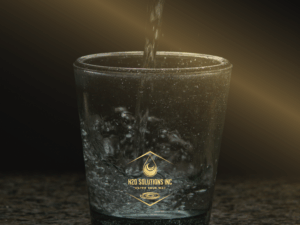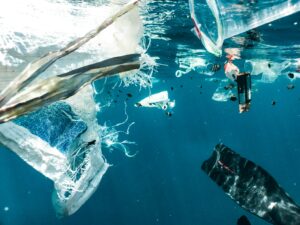There are many different types of water filtration systems. This guide delves into one of the most effective methods: reverse osmosis (RO) filtration. Join us as we unravel the science behind RO, explore the quality of its purified water, and weigh its advantages and disadvantages. By the end of this journey, you’ll clearly understand whether RO filtration aligns with your needs. At H2O Solutions, we’re committed to empowering our Spokane, Washington community with the knowledge to make informed decisions about their water filtration needs.
What is Reverse Osmosis in Simple Words
Reverse osmosis filters dirty water through a semi-permeable membrane with microscopic pores, allowing only all water molecules to pass through. The RO membrane pore size is ~0.0001 micron. It effectively removes chemical contaminants, protozoans, bacteria, and viruses. Once only the water molecules pass through, the water is safe enough for drinking, washing, cooking, and more.
How Does Reverse Osmosis Work
To illustrate how RO works, let’s consider brackish water as an example. Brackish water has a higher salt level than fresh water but lower than seawater. RO systems are employed to desalinize brackish water. In reverse osmosis filtration, pressure is applied to brackish water, pushing it through the semi-permeable membrane. This process leaves behind salt and other impurities, providing fresh water. As it operates under pressure rather than heat, it serves as an alternative to distillation for water purification.
What is the Difference Between Filter and Reverse Osmosis
Both filtration and reverse osmosis can remove suspended particles and microorganisms. However, filtration falls short in removing dissolved substances from the water. RO systems can remove dissolved chemicals by using pressure to push water through its semi-permeable membrane.
Spokane Water Quality and the Role of RO Systems
Spokane’s drinking water source is the Spokane Valley-Rathdrum Prairie Aquifer. However, this aquifer’s water carries a moderate hardness, attributed to its journey through the rock and sand formations of Glacial Lake Missoula. While moderately hard water poses no immediate health risks, its long-term effects can impact appliance efficiency and household chores. The drawbacks of hard water are evident from diminished appliance lifespans to increased soap usage for cleaning.
Enter reverse osmosis (RO) systems, the solution to Spokane’s hard water woes. RO systems extend the longevity of pipes and appliances by selectively filtering out minerals like calcium and magnesium, notorious culprits of water hardness. Moreover, the transition to soft water translates into tangible savings on cleaning products, as less soap is needed for laundry, dishwashing, and personal hygiene. Explore the myriad benefits of soft water to unlock its full potential.
Is It Healthy to Drink Reverse Osmosis Water
RO systems do not compromise the healthiness of the produced water. They efficiently remove harmful microorganisms and dissolved chemicals. Water can become more acidic if minerals are removed, and this has raised concerns for people who prefer to drink alkaline water.
Is Reverse Osmosis Water Acidic
Water produced by RO systems tends to be slightly more acidic, with a pH level of 6-6.5, falling within EPA water standards. For those desiring mineralized drinking water, RO system options include filters that fortify the water with minerals and electrolytes.
What are the Advantages of the Reverse Osmosis Water System
According to the CDC, while various treatment systems can eliminate microorganisms with varying success, only distillation and RO systems can effectively remove microorganisms and dissolved substances from the water.
Removes Lead that leaks from Old Lead Pipes
Old lead pipes are common in the US. When these pipes corrode, the lead dissolves in the water. Even in trace amounts, lead can cause adverse effects on the body, including nerve damage and fertility conditions. RO systems can be used to purify residential water.
Fortunately for Spokane City, they have replaced all remaining lead pipes in their water system as of July 2018.
Lessens Sodium Intake from Drinking Water
RO systems, adept at desalinating water, also remove 90-95% sodium in water supplies. This aids individuals in leading a healthier lifestyle, mitigating the risk of high blood pressure. An RO system, in particular, benefits those monitoring their sodium levels.
Safe for Cancer Patients Immunocompromised from Radiotherapy
Water from RO systems contains no harmful microbes, ensuring its safety for individuals undergoing radiotherapy with compromised immune systems.
Water Without Minerals Have Their Own Uses
While water from RO systems is clean and safe for cooking, it can enhance the taste of food as it lacks minerals. Pet owners raising fish or coral can also utilize mineral-free water.
More Environmentally Friendly and Energy-Efficient in Certain Communities
Some areas can have long-term Boil Water Advisories. This can cause increased energy bills or increased waste from disposable plastic bottles. In 2003, the RO system with biological treatment became the answer for Yellow Quill First Nation’s nine-year advisory.
What are the Disadvantages of the Reverse Osmosis Water System
While RO systems are one of the most effective and safest ways to filter water, they have drawbacks that only make them suitable in certain situations. They should be used when traditional water treatment systems aren’t applicable.
Wastes Significantly More Water Than It Produces
According to the EPA, some RO systems use three times as much water as they treat. Some RO systems for households only produce 5-15% of the water they filter. This can affect the environment and increase energy and water bills. Fortunately, they can be used as the last stage of water purification in water treatment facilities.
Removes Healthy Minerals Present in Water
RO systems strip water of minerals, potentially depriving the body of essential elements like calcium, magnesium, and municipally added fluoride -especially if they do not have a healthy and balanced diet. To address this, most RO systems include mineral beads or filters to reintroduce beneficial minerals.
Costly Installation and Requires Expensive Maintenance
RO systems are not for developing countries due to their complex installation and rigorous maintenance, which cause them to be costly. For example, the Melbourne plant in Australia provides a third of Perth’s water supply. It cost $3.3 billion to build in 2012. Since 2019, operation costs have cost taxpayers $649 million yearly.
When is Reverse Osmosis Applicable
While proven effective in filtering harmful microbes, particles, and dissolved chemicals, RO systems have associated high costs and waste production. Their applicability extends to industrial and household settings based on specific criteria.
Wastewater Treatment
While RO systems can waste more water than they can produce, they can be made as the last stage of treatment in many water treatment facilities for filtering out bacteria, chemicals, and other dissolved impurities from the water.
Industrial to Residential and Commercial
More developed countries may better handle the costs of RO systems, such as desalination plants, than developing countries. In specific communities where traditional filtration systems aren’t applicable due to long-term chemical contamination, an installed RO unit can serve as a viable solution.
Household
A household RO system can suit residents with specific needs and preferences. Because a standard RO system can generate a lot of wastewater, EPA made the WaterSense labeling for RO systems that meet prescribed performance standards.
Ensuring Pure Water with Reverse Osmosis
RO systems guarantee clean and safe drinking water across various scales. If you think an RO system applies to your area in Spokane, Washington, please contact us to learn more. Explore our Reverse Osmosis page for industrial installations and H2O Solutions Counter Top Reverse Osmosis for household options to learn more about RO systems.
Sources
- Scavetta, A. (n.d.). “The Pros and Cons of Reverse Osmosis Filtration.” Aquasana. Retrieved January 29, 2024, from https://www.aquasana.com/info/the-pros-and-cons-of-reverse-osmosis-filtration-pd
- BYJU’s. (n.d.). “Reverse Osmosis.” Retrieved January 29, 2024, from https://byjus.com/chemistry/reverse-osmosis/
- Clear Water Concepts. (n.d.). “Is Reverse Osmosis Water Bad for You?” Retrieved January 29, 2024, from https://clearwaterarizona.com/resource/is-reverse-osmosis-water-bad-for-you/
- Centers for Disease Control and Prevention. (n.d.). “A Guide to Drinking Water Treatment Technologies for Household Use.” Retrieved January 29, 2024, from https://www.cdc.gov/drinking-water/about/about-home-water-treatment-systems.html?C[…]er/drinking/home-water-treatment/household_water_treatment.html
- Britannica. (n.d.). “reverse osmosis.” Retrieved January 29, 2024, from https://www.britannica.com/science/reverse-osmosis
- United States Environmental Protection Agency. (n.d.). “Point-of-Use Reverse Osmosis Systems.” Retrieved January 29, 2024, from https://www.epa.gov/watersense/point-use-reverse-osmosis-systems
- Kershner, K. (2023, May 12). “How Reverse Osmosis Works.” How Stuff Works. Retrieved January 29, 2024, from https://science.howstuffworks.com/reverse-osmosis.htm#pt3
- Safe Driving Water Foundation. (n.d.). “Ultrafiltration, Nanofiltration and Reverse Osmosis.” Retrieved January 29, 2024, from https://www.safewater.org/fact-sheets-1/2017/1/23/ultrafiltrationnanoandro
- AAA Water Systems. (n.d.). “5 Health Benefits of Reverse Osmosis Water.” Retrieved January 29, 2024, from https://aaawater.org/5-health-benefits-of-reverse-osmosis-water/
- Crail, C. and Allen, S. (2023, April 20). “Learn The Pros And Cons Of Reverse Osmosis Water Filtration Systems.” Forbes Home. Retrieved January 29, 2024, from https://www.forbes.com/home-improvement/home/reverse-osmosis-water-pros-cons/
- Poposki, C. (2018, May 20). “Melbourne desalination plant costs tax-payers an eye-watering $649 million in annual operating charges.” Daily Mail. Retrieved January 29, 2024, from https://www.dailymail.co.uk/news/article-5749621/Melbourne-desalination-plant-costs-tax-payers-eye-watering-649-million-year-operate.html
- Sensorex. (2023, January 15). “Industrial Applications of Reverse Osmosis (RO) Systems.” Retrieved from https://sensorex.com/reverse-osmosis-ro-systems/#What_Industries_Can_RO_Be_Used_In
- Liberty Lake Sewer and Water District. (n.d.). “Water Hardness.” Retrieved from February 27, 2024, from https://libertylake.org/water-hardness/
- My Spokane. (n.d.). “Our Water.” Retrieved from February 27, 2024, from https://my.spokanecity.org/publicworks/water/quality/
Questions? We’re Here to Help
Navigating the maintenance and care of your EcoWater treatment system is vital to ensuring its lasting efficiency and performance. Whether it’s understanding salt maintenance, troubleshooting regeneration issues, or planning system deep cleaning, our team, as an EcoWater Systems distributor, is here to assist you every step of the way. Contact us today.




